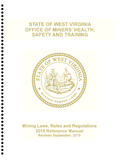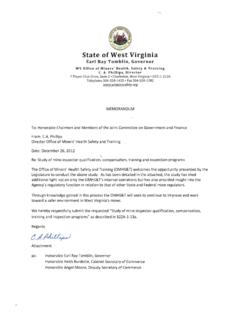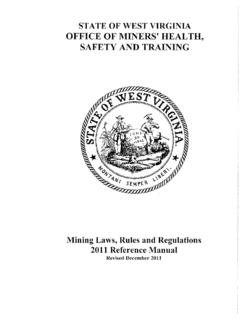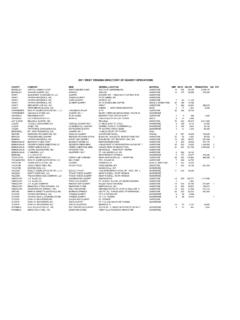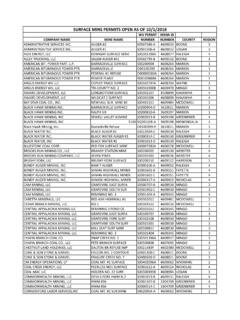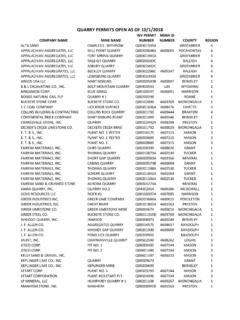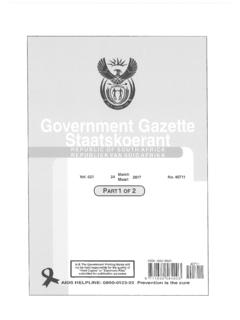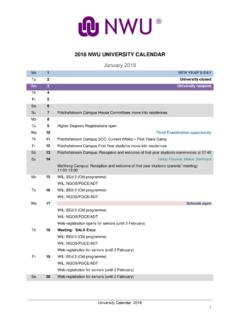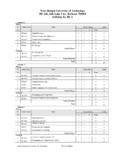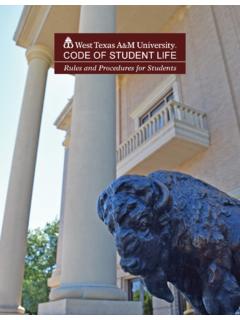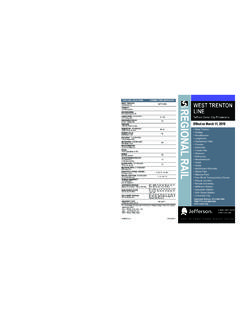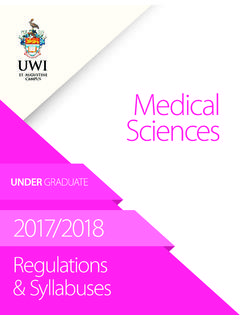Transcription of West Virginia Office of Miners’ Health, Safety and ...
1 DEVELOPING A COMPREHENSIVE EMERGENCY PREPAREDNESS PLANNING MANUAL FOR UNDERGROUND MINING OPERATIONS west Virginia Office of Miners Health, Safety and Training and west Virginia university Mining Extension Service December 2008 ACKNOWLEDGEMENT This manual is the result of a 2007/2008 Brookwood Sago Mine Safety Grant. This grant, one of several awarded in 2007 by the US Department of Labor s Mine Safety and Health Administration, was awarded to the west Virginia Office of Miners Health, Safety and Training on September 30, 2007. west Virginia university Mining Extension Service was a sub-recipient of the grant. This product was funded by a grant awarded under the Brookwood-Sago Mine Safety Grant as implemented by the US Department of Labor s Mine Safety and Health Administration.
2 The information contained in this product was created by a grantee organization and does not necessarily reflect the official position of the US Department of Labor. All references to non-governmental companies or organizations, their services, products, or resources are offered for informational purposes and should not be construed as an endorsement by the Department of Labor. The product is copyrighted by the institution that created it and intended for individual organizational, non-commercial use. 1 PREFACE An underground coal mine crew of thirteen miners travels in a mantrip to their working section at the beginning of the shift.
3 One miner is left off at the belt drive. Suddenly, they are engulfed with smoke and dust. Unbeknownst to them, an explosion has occurred behind a sealed area and ventilation controls for their working section have been destroyed. The miners on the section eventually don their self-contained self-rescuers (SCSR s) and attempt to get out of the mine. They find their escapeways and other means of egress blocked. They retreat back toward the face and hurriedly construct a barricade. Many hours later, 11 of the miners are found dead in the barricade by a mine rescue team. The miner left at the belt was killed by the initial explosion. A fire occurs at an underground belt conveyor drive.
4 Smoke and dangerous levels of carbon monoxide travel into an adjacent working section. The miners don their SCSR s and begin to travel out the mine. Two of the miners get separated from the rest of the crew in heavy smoke and are unable to find their way out. They are later found dead by a mine rescue team. No underground coal mine is immune from a major disaster. Major mine emergencies can occur at anytime and from a number of causes. Throughout the history of mining, mine emergencies have caused the loss of hundreds of miners, destruction of property, physical and psychological upheaval and enormous financial burden. We can not prevent all mining disasters, but we can, through well designed emergency preparedness planning, mitigate or minimize their effects.
5 If an emergency preparedness plan is well designed, properly implemented and periodically reviewed, it can greatly enhance a mining company s ability to respond effectively and efficiently to most underground emergencies and significantly reduce the potential loss or injury of miners and property. 2 When it comes to emergency preparedness planning, it is paramount that every conceivable action, reaction, response, resource and emotion be considered even if such considerations may later be dismissed as nonessential to the emergency preparedness effort. The whole purpose of emergency preparedness planning is to anticipate future emergency situations and requirements and then to apply effective and efficient countermeasures.
6 Obviously, the development of a comprehensive emergency preparedness plan requires considerable time and effort. However, the planning effort can yield valuable dividends. Emergency preparedness planning protects lives, equipment and property. The emergency preparedness plan focuses on what types of emergencies can effect your mining operations; who will lead and make decisions during an emergency; and what procedures are put in place to ensure an effective response. It must be viewed as a dynamic, ongoing and ever-changing process. The core elements of the plan are planning, prevention, preparation, response and recovery actions. The planning process is a key element that forces mine management and labor to explore viable options that can be employed to prevent or reduce the consequences of an emergency.
7 A major component of the prevention phase is risk assessment and analysis. This manual is designed to prepare mine operators with a systematic guide to manual is not new. It has been used by Safety professionals in other industries for decades. This manual provides both a proactive and reactive approach for safeguarding a mining operation s miners and property assets. It can be an important guide for times of great stress, confusion and frustration. Lee Whistler once wrote, Few people plan to fail, they just fail to plan. Mine emergencies happen. Emergency preparedness planning before an emergency situation is the key to preventing and controlling these events.
8 3 TABLE OF CONTENTS I. INTRODUCTION A. What is an Emergency? B. What is Emergency Management? C. Why Have a Plan? II. ESTABLISH THE PLANNING TEAM A. Who s on the Team B. Authority of the Team C. Develop a Mission Statement D. Establish a Schedule and Budget III. ANALYZE CAPABILITIES AND HAZARDS A. Review Internal Plans, Policies, and State and Federal Regulations B. Evaluate Internal and External Sources C. Conduct a Risk Assessment IV. DEVELOP THE PLAN A. Executive Summary B. Emergency Management Elements C. Emergency Response Procedures D. Recovery Actions V. TEST THE PLAN VI. IMPLEMENT THE PLAN VII.
9 REFERENCES APPENDIX A Miner Act APPENDIX B Mine Rescue Handbook APPENDIX C Responsible Person Training 4 I. INTRODUCTION A. What is An Emergency? An emergency that occurs at an underground coal mine or the surface areas of an underground coal mine can be defined as any unplanned event that causes serious injuries or loss of life; causes extensive property damage; shuts down or disrupts the mining operations; or threatens the operation s financial standing or public image. Emergency preparedness plans are often referred to as disaster plans. The distinction is that a well designed and executed emergency preparedness plan can eliminate or control hazards so they don t become a disaster; or if this isn t possible, it can turn a potential disaster into a well managed situation with minimal effect on the miners and property of the mining operation.
10 Although the Mine Safety and Health Administration (MSHA) does not define an emergency, it does include three (3) types of incidents under the Mine Improvement and Emergency Response Act (Miner Act) that requires a mine operator to notify the Secretary within fifteen (15) minutes from realizing the occurrence of one of the following events: 1. The death of an individual at the mine. 2. An injury of an individual at the mine which has a reasonable potential to cause death; or 3. The entrapment of an individual at the mine which has reasonable potential to cause death. MSHA has set stiff monetary penalties for failing to report these events in the specified time.
